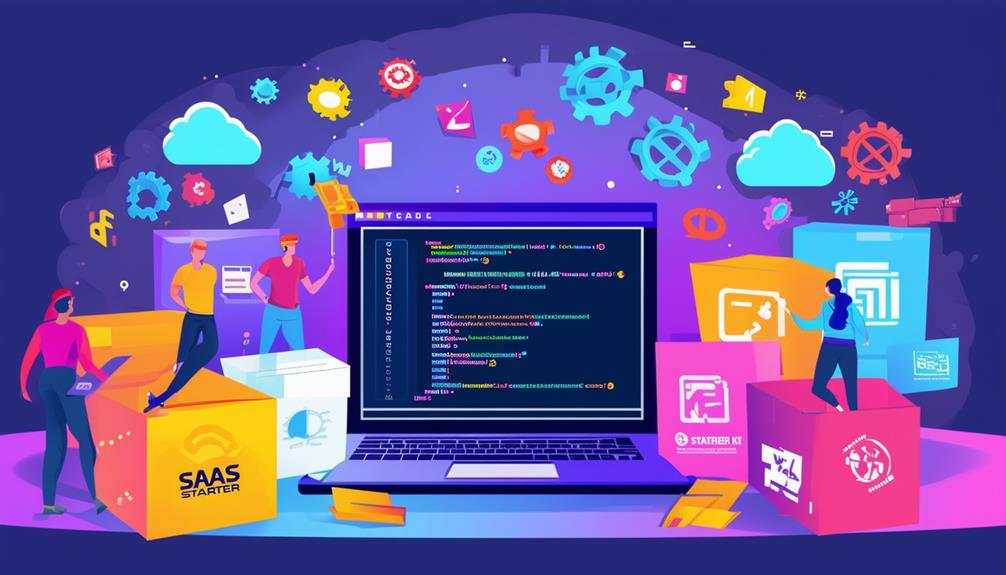When you’re considering a SaaS starter kit for your project, you’ll need to navigate a minefield of potential pitfalls. From scalability issues to hidden costs, these prepackaged solutions can present unexpected challenges. You’ll want to carefully evaluate the kit’s limitations, security features, and long-term viability before committing. By understanding common stumbling blocks, you can make an informed decision that aligns with your business goals and technical requirements. But knowing what to look for is just the beginning – there’s more to uncover about maximizing the benefits of SaaS starter kits while minimizing risks.
Understanding SaaS Starter Kit Limitations
Many SaaS starter kits promise rapid development but often come with hidden limitations that can hinder your project’s scalability and customization. To avoid these pitfalls, you’ll need to understand the common constraints these kits impose.
First, examine the technology stack. Most starter kits are built on specific frameworks and languages, which may not align with your long-term goals or team expertise. Research shows that 68% of developers prefer flexibility in choosing their tech stack.
Next, consider scalability. While starter kits can get you up and running quickly, they may struggle with high user loads. A study by TechRepublic found that 47% of SaaS companies face scaling issues within their first year.
Customization is another vital factor. Many kits offer limited options for UI/UX modifications, potentially impacting your brand identity. According to a Salesforce survey, 84% of customers say the experience a company provides is as important as its products or services.
Lastly, be aware of licensing restrictions. Some starter kits come with usage limitations or require ongoing fees. Always read the fine print to avoid unexpected costs or legal issues down the line.
Assessing Scalability Challenges
When you’re evaluating a SaaS starter kit, it’s important to evaluate its ability to handle increased user loads, data volumes, and feature expansions without compromising performance or user experience.
Start by examining the kit’s architecture and database design. Look for features like microservices, containerization, and horizontal scaling capabilities that can support growth.
Analyze the kit’s database performance under various load scenarios. Test its ability to handle concurrent users and transactions, confirming it can scale without significant latency. Consider the kit’s caching mechanisms and query optimization techniques to maintain speed as data volumes increase.
Evaluate the starter kit’s API design and third-party integrations. Verify they’re built to accommodate increased traffic and data throughput. Look for rate limiting and throttling features to prevent system overload.
Examine the kit’s flexibility for adding new features and modules. Check if it supports plug-and-play components or requires extensive code modifications for expansions. This flexibility is critical for adapting to evolving business needs.
Lastly, review the kit’s monitoring and analytics capabilities. These tools are essential for identifying bottlenecks and optimizing performance as your SaaS application grows.
Evaluating Customization Options
While scalability guarantees your SaaS can grow, customization options determine how well it can adapt to your unique business needs and user preferences. When analyzing a SaaS starter kit, evaluate its flexibility in three key areas: UI/UX, functionality, and data models.
First, examine the kit’s front-end customization capabilities. Can you easily modify colors, layouts, and branding elements? Look for component-based architectures that allow for modular design changes without overhauling the entire interface.
Next, scrutinize the API and extension system. A well-designed kit should offer hooks and plugins for adding custom features. Check if it supports third-party integrations and allows you to build proprietary modules.
Lastly, evaluate the data model’s adaptability. Can you add custom fields, create new relationships, or modify existing schemas? This flexibility is essential for accommodating industry-specific requirements.
When analyzing customization options, consider the trade-off between flexibility and maintenance complexity. Highly customizable kits may require more development resources to maintain. Balance your need for uniqueness with long-term sustainability.
Analyzing Long-Term Cost Implications
Beyond initial setup costs, you’ll need to carefully assess the long-term financial implications of adopting a SaaS starter kit for your project. Consider factors such as recurring subscription fees, potential scaling costs, and hidden expenses that may arise as your user base grows.
Analyze the pricing structure of the starter kit provider. Many offer tiered plans, which can greatly impact your budget as you scale. Research historical price increases to anticipate future costs. Factor in additional expenses like third-party integrations, custom development, and maintenance.
Don’t overlook opportunity costs. While a starter kit may save time initially, it could limit your ability to optimize and differentiate your product in the long run. Calculate the potential revenue impact of these limitations.
Consider the cost of migrating away from the starter kit if needed. This includes data export fees, development time for a new solution, and potential downtime. Compare these long-term costs against building a custom solution from scratch.
Lastly, evaluate the financial stability of the starter kit provider. A provider’s bankruptcy or discontinuation of service could lead to unexpected costs and disruptions for your business.
Addressing Security Concerns
After considering the financial aspects, you’ll need to turn your attention to the critical issue of security when evaluating SaaS starter kits. Security vulnerabilities can expose your business to data breaches, financial losses, and reputational damage.
Start by examining the kit’s built-in security features, such as encryption protocols, authentication mechanisms, and access controls. Verify that the starter kit complies with industry standards like GDPR, HIPAA, or PCI-DSS, depending on your sector. Check for regular security updates and patches from the kit’s provider. Implement additional security layers, including multi-factor authentication and role-based access control.
Don’t overlook data storage and transmission security. Confirm that the kit uses secure protocols like HTTPS and offers data encryption at rest and in transit. Evaluate the provider’s data center security measures and backup policies.
Consider conducting a third-party security audit of the starter kit before implementation. This can help identify potential vulnerabilities that may not be immediately apparent.
Navigating Integration Complexities
SaaS starter kits’ integration capabilities can make or break your project’s success, demanding careful evaluation and strategic planning. When maneuvering through integration complexities, you’ll need to evaluate the kit’s compatibility with your existing tech stack and future scaling needs.
Start by identifying your core integration requirements, such as API connectivity, data synchronization, and third-party service support.
Evaluate the kit’s documentation quality and community support for integration issues. Look for pre-built connectors and well-documented APIs to streamline the process.
Be aware of potential limitations in customization options, as some kits may restrict your ability to modify integration points. Consider the scalability of integrations, ensuring they can handle increased data volumes and user loads as your SaaS grows.
Pay attention to authentication and data mapping capabilities, as these often present challenges during integration. Test the kit’s error handling and logging features for integration-related issues.
Handling Technical Debt
Technical debt is an inevitable challenge when using SaaS starter kits, but you can mitigate its impact by implementing proactive strategies and regular code reviews.
Start by documenting all borrowed code and third-party dependencies, creating a clear roadmap for future updates and replacements. Implement automated testing to catch potential issues early, reducing the accumulation of hidden technical debt.
Prioritize refactoring sessions in your development cycle, dedicating time to improve code quality and reduce complexity. Use static code analysis tools to identify areas of concern and track technical debt metrics over time. Establish coding standards and enforce them through peer reviews and automated checks.
Consider adopting a microservices architecture to isolate components and make them easier to update or replace. Regularly assess the performance and scalability of your SaaS application, addressing bottlenecks before they become critical issues.
Keep your development team educated on best practices and emerging technologies to prevent the introduction of outdated or inefficient code.
Mitigating Vendor Lock-In Risks
While managing technical debt is key, equally important is addressing the risk of vendor lock-in when using SaaS starter kits. Vendor lock-in can limit your flexibility and increase costs over time. To mitigate this risk, you’ll need to adopt strategic approaches.
First, prioritize open-source technologies and standard APIs. These allow for easier migration and integration with other systems. According to a 2022 Red Hat survey, 80% of IT leaders believe open-source software is critical to their organization’s strategy.
Implement a multi-cloud strategy to avoid dependence on a single provider. Gartner predicts that by 2025, 75% of enterprise customers will adopt a multi-cloud or hybrid cloud strategy.
Regularly assess your dependencies and look for alternatives. This includes both technical components and third-party services. Maintain detailed documentation of your system’s architecture and integration points.
Consider containerization technologies like Docker and Kubernetes. These enhance portability across different environments. A 2021 CNCF survey found that 96% of organizations are using or evaluating Kubernetes.
Ensuring Regulatory Compliance
Regulatory compliance poses a significant challenge when adopting SaaS starter kits, especially in industries with strict data protection and privacy laws. You’ll need to carefully evaluate the kit’s built-in compliance features and assess whether they meet your specific regulatory requirements. Start by identifying the key regulations that apply to your industry, such as GDPR, HIPAA, or PCI DSS.
Next, conduct a thorough review of the starter kit’s documentation and features related to data handling, encryption, and access controls. Look for certifications or compliance attestations provided by the kit’s developers. If gaps exist, you’ll need to implement additional measures to guarantee full compliance.
Don’t forget to reflect on data residency requirements, as many regulations mandate data storage within specific geographic regions. Verify that the kit allows you to choose data center locations that align with your compliance needs.
Regularly audit your implementation and stay informed about regulatory changes. Many SaaS starter kits offer automatic updates, but you’re ultimately responsible for maintaining compliance.
Think about engaging legal experts or compliance consultants to review your setup and provide guidance on ongoing compliance management.
Optimizing Performance and Efficiency
Performance enhancement can make or break your SaaS application, even when you’re starting with a well-designed kit. To avoid common pitfalls, focus on key areas that impact user experience and system efficiency.
First, optimize database queries. Implement indexing, caching, and query optimization techniques to reduce response times. According to a 2022 study by New Relic, poorly optimized queries can account for up to 70% of application performance issues.
Next, leverage content delivery networks (CDNs) to distribute static assets globally. This can reduce latency by up to 50% for users in different geographical locations. Implement lazy loading for images and scripts to improve initial page load times.
Monitor and optimize server resources. Use auto-scaling to handle traffic spikes and prevent downtime. Implement efficient memory management and garbage collection to avoid resource leaks.
Regularly profile your application to identify bottlenecks. Tools like New Relic or Datadog can help you pinpoint performance issues in real-time. Address these proactively to maintain peak efficiency.
Lastly, optimize your frontend code. Minify and compress assets, use efficient JavaScript libraries, and implement code splitting to reduce bundle sizes. This can lead to a 30% improvement in load times, according to Google’s PageSpeed Insights.
To Wrap Up
You’ve now got the tools to navigate SaaS starter kit pitfalls.
Remember to prioritize scalability, customization, and cost-effectiveness.
Don’t overlook security and compliance measures.
Stay vigilant about technical debt and vendor lock-in risks.
Regularly assess and optimize your system’s performance.
By following these guidelines, you’ll set your SaaS project up for long-term success.
Keep adapting to industry trends and user needs to maintain your competitive edge in the rapidly evolving SaaS landscape.






